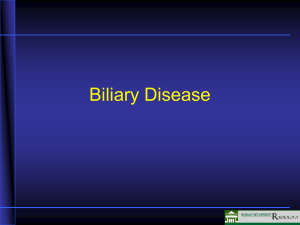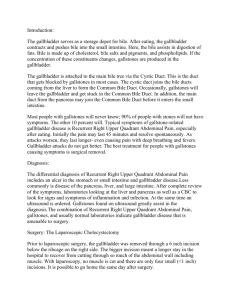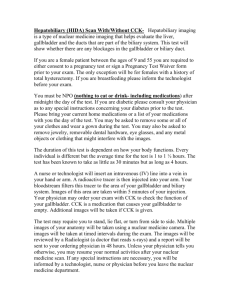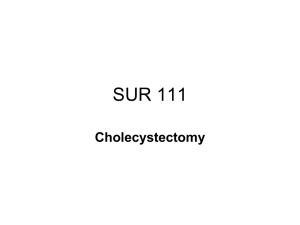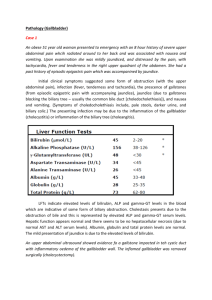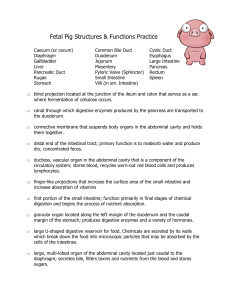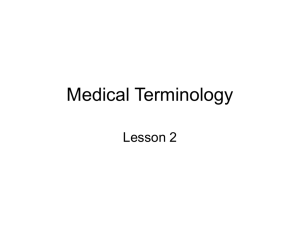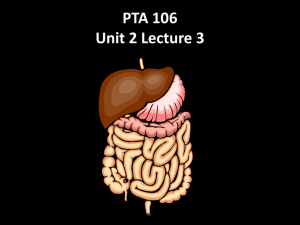Gallbladder - UCSF Emergency Medicine Ultrasound
advertisement
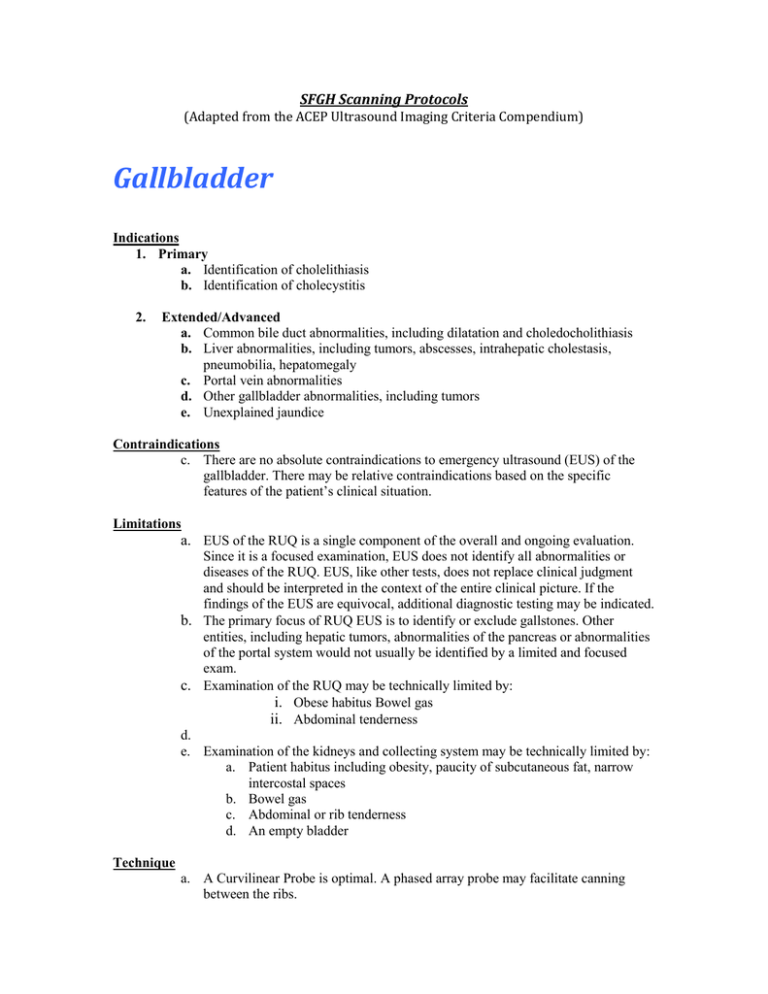
SFGH Scanning Protocols (Adapted from the ACEP Ultrasound Imaging Criteria Compendium) Gallbladder Indications 1. Primary a. Identification of cholelithiasis b. Identification of cholecystitis 2. Extended/Advanced a. Common bile duct abnormalities, including dilatation and choledocholithiasis b. Liver abnormalities, including tumors, abscesses, intrahepatic cholestasis, pneumobilia, hepatomegaly c. Portal vein abnormalities d. Other gallbladder abnormalities, including tumors e. Unexplained jaundice Contraindications c. There are no absolute contraindications to emergency ultrasound (EUS) of the gallbladder. There may be relative contraindications based on the specific features of the patient’s clinical situation. Limitations a. EUS of the RUQ is a single component of the overall and ongoing evaluation. Since it is a focused examination, EUS does not identify all abnormalities or diseases of the RUQ. EUS, like other tests, does not replace clinical judgment and should be interpreted in the context of the entire clinical picture. If the findings of the EUS are equivocal, additional diagnostic testing may be indicated. b. The primary focus of RUQ EUS is to identify or exclude gallstones. Other entities, including hepatic tumors, abnormalities of the pancreas or abnormalities of the portal system would not usually be identified by a limited and focused exam. c. Examination of the RUQ may be technically limited by: i. Obese habitus Bowel gas ii. Abdominal tenderness d. e. Examination of the kidneys and collecting system may be technically limited by: a. Patient habitus including obesity, paucity of subcutaneous fat, narrow intercostal spaces b. Bowel gas c. Abdominal or rib tenderness d. An empty bladder Technique a. A Curvilinear Probe is optimal. A phased array probe may facilitate canning between the ribs. b. As with other EUS, the organs of interest are scanned methodically through all tissue planes in at least two orthogonal directions. c. Gallbladder Evaluation i. The normal gallbladder is highly variable in size, shape, axis, and location. It may contain folds and septations, and may lie anywhere between the midline and the midaxillary line. The axis and location of the porta hepatis are also highly variable. Orientation of images of the gallbladder and common bile duct are conventionally defined with respect to their axes as longitudinal, transverse, and oblique, rather than standardized anatomic planes such as sagittal, coronal, oblique and transverse. ii. In most cases, the gallbladder lies immediately posterior to the inferior margin of the liver in the mid-clavicular line. In some patients, the fundus may extend several centimeters below the costal margin; in others, the gallbladder may be high in the hilum of the liver, almost completely surrounded by hepatic parenchyma. In order to avoid confusing it with fluid-filled tubular structures, the entire extent of the gallbladder should be scanned in its long and short axes. iii. In most patients, the inferior margin of the liver provides a sonographic window for the gallbladder below the costal margin. In many cases, this window can be augmented by asking the patient to take and hold a deep breath. It may also be helpful to place the patient in a left decubitus position. The transducer is placed high in the epigastrium with the indicator in a cephalad orientation. The probe is swept laterally while being held immediately adjacent to the costal margin. The liver margin should be maintained within the field of view on the screen. iv. When the gallbladder has been located, its long and short axes are identified. In the long axis, images are obtained, by convention, with the gallbladder neck on the left of the screen, and the fundus on the right. The gallbladder is scanned systematically through all tissue planes in both long and short axis views. In many patients, a combination of subcostal and intercostal windows allow for views of the gallbladder from multiple directions and may help identify small stones, resolving artifacts, and examining the gall bladder neck. d. Common Bile Duct View i. The common bile duct is most easily located sonographically by finding and identifying the portal vein and hepatic artery, which comprise the portal triad. Several techniques can be used to locate the common bile duct in addition to anatomic location. These include tracking the hepatic artery from the celiac axis, tracking the portal vein from the confluence of the splenic and superior mesenteric veins, and following the portal vessels in the liver to the hepatic hilum. In a transverse view of the portal triad, the common bile duct and hepatic artery are typically seen anterior to the portal vein. The common bile duct is usually more lateral than the hepatic artery or more to the left on the screen. It can also be distinguished by its absence of a color flow Doppler signal if this modality is employed. Keys to Gallbladder Ultrasound a. The gallbladder is systematically scanned with particular attention to the neck. For patients with low-lying gallbladder, the fundus may be obscured by gas-filled colon. Left Lateral decubitus positioning or inhalation may help provide adequate windows in this situation. The principal abnormal finding is gallstones that are echogenic with distal shadowing. Measurement of wall thickness, if performed, is made on the anterior wall between the lumen and the hepatic parenchyma. Measurements of gallbladder size are rarely helpful in EUS, although gross increases in transverse diameter or overall size may be evidence of cholecystitis and hydrops, respectively. A qualitative assessment of the wall and pericholecystic regions should also be made, looking for mural irregularity, breakdown of the normal trilaminar mural structure, and fluid collections. b. The common bile duct, like other tubular structures, is most accurately measured when imaged in a transverse plane. It is most reliable to measure the intraluminal diameter (inside wall to inside wall). Anatomically, it is preferable to measure the common bile at its largest diameter, which typically occurs extra-hepatic ally. Identification of the common bile duct in this location is best achieved with long axis visualization, rather than the transverse orientation. Becoming facile with imaging in both planes is a key element to successful measurements of the common bile duct. Evaluation of the common bile duct may reveal shadowing suggesting stones and/or comettail artifact suggesting pneumobilia. The question of such findings would warrant additional diagnostic testing. Pathologic Findings a. Cholelithiasis - Gallstones are often mobile (move with patient positioning) and usually cause shadowing. Optimization of gain, frequency and focal zone settings may be necessary to identify small gallstones and to differentiate their shadows from those of adjacent bowel gas. b. c. d. Cholecystitis - This diagnosis is based on the entire clinical picture in addition to the findings of the EUS. The following sonographic findings support the diagnosis of cholecystitis. a. Thickened, irregular, or heterogeneously echogenic gallbladder wall is measured along the anterior surface. Thickness greater than 3 millimeters is considered abnormal. b. Pericholecystic fluid may appear as hypo- or an-echoic regions seen along the anterior surface of the gallbladder within the hepatic parenchyma and suggests acute cholecystitis. c. A Sonographic Murphy’s sign is tenderness reproducing the patient’s abdominal pain elicited by probe compression directly on the gallbladder, combined with the absence of similar tenderness when it is compressed elsewhere. d. Increased gallbladder diameter greater than 10x4 cm may be evidence of cholecystitis. Common bile duct dilatation - The normal upper limit of common bile duct diameter has been described as 3 mm, although several studies have demonstrated increasing diameter with aging in patients without evidence of biliary disease. For this reason, many authorities consider that the normal common bile duct may increase by 1 mm for every decade of age. Pathologic findings of the liver and other structures are beyond the scope of the EUS. Pitfalls a. When bowel gas or other technical factors prevent an adequate examination, b. c. d. e. f. g. h. i. j. k. l. m. n. these limitations should be identified and documented. As usual in emergency practice, such limitations may mandate further evaluation by alternative methods. Failure to identify the gallbladder may occur with chronic cholecystitis, particularly when filled with stones (WES sign), or, in the rare instances of gallbladder agenesis. Failure to identify the gallbladder should warrant additional diagnostic imaging. The gallbladder may be confused with other fluid filled structures including the portal vein, the inferior vena cava, and hepatic or renal cysts or loculated collections of fluid. These can be more accurately identified with careful scanning in multiple planes. Measurement of posterior gallbladder wall thickness may be inaccurate due to layered gallstones, acoustic enhancement from bile, and closely apposed loops of bowel. Consequently, measurement of gallbladder wall thickness should be made on the anterior wall, adjacent to the hepatic parenchyma. Small gallstones may be overlooked or mistaken for gas in an adjacent loop of bowel. In questionable cases, gain settings should be optimized, the area should be scanned in several planes, and the patient should be repositioned to check for the mobility of gallstones. Gas in loops of bowel adjacent to the posterior wall of the gallbladder may be mistaken for stones. Intraluminal gas can be distinguished by noting peristalsis and specifically identifying the bowel wall. Stones are characterized by anechoic shadowing and movement with patient repositioning. Small stones in the gallbladder neck may easily be overlooked or mistaken for lateral cystic shadowing artifact (edge shadows). It may be necessary to image this area in several planes to avoid this pitfall. Common bile duct stones may only be identified by the shadowing they cause. Cholesterol stones are often small, less echogenic, may float, and may demonstrate comet tail artifacts. Pneumobilia and emphysematous cholecystitis are subtle findings and may produce increased echogenicity and comet–tail artifact caused by gas in the biliary tree and gallbladder wall. Polyps may be mistaken for gallstones. The former are non-mobile, do not shadow, and are adjacent and attached to the inner gallbladder wall. Polyps are many times not in the dependent portion of the gallbladder. Gallbladder wall thickening may not represent biliary pathology, but may be physiological, as in the post-prandial state, or with non-surgical conditions such as hypoproteinemia and congestive heart failure. The presence of gallstones or other findings consistent with cholecystitis does not rule out the presence of other life-threatening causes of epigastric pain such as aortic aneurysm or myocardial infarction. Except for emergency physicians with extensive experience in EUS, evaluations of the liver, pancreas and Doppler examination of the portal venous system are not part of the normal scope of EUS of the RUQ.
